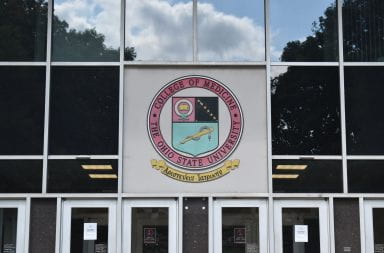
Ohio State students began receiving dining and housing refunds April 3 due to COVID-19. Credit: Lantern File Photo
Whether your refund was $48 or more than $1,500, experts say it’s best not to splurge.
Ohio State students began receiving dining and housing refunds April 3 after the university moved nearly all students off campus and closed libraries, recreational facilities and dining halls due to COVID-19. All students received refunds for recreational fees, and students living in residence halls with meal plans received additional prorated refunds for housing and dining.
Students living in residence halls received between $1,271.25 and $1,693.80, depending on the rate of their residence hall and room type, university spokesperson Dave Isaacs said in an email. Rate III housing costs $3,371 per semester and Rate I housing costs $4,329. Students received a $48 refund for the recreational fee.
It was in the first of two waves that students who moved out of residence halls March 14-22 received, Isaacs said. He said more than 15,000 students received refunds in the first week.
Students who moved out of residence halls after March 22 or lived off campus were included in the second wave beginning April 10, Isaacs said.
Ben Raines, a financial education wellness coordinator in the Office of Student Life, said students should be intentional with how they spend their refunds.
“It’s not clear how long this economic issue might extend beyond this. It’s not clear what effect that might have on any of our lives going forward,” Raines said.
Students have a few options of how to use their refunds, he said.
Paying off high-interest debt
In the first quarter of 2020, about 43 million Americans had debt from federal student loans, totaling $1.5 trillion, with each American owing $35,397 on average, according to data from the Federal Student Loan Portfolio. Though the number of borrowers increased by 150 percent since 2007, the total loan debt has grown nearly 300 percent in the past 13 years.
Raines said students should consider reducing the principal — the original amount owed on a loan — which would decrease the total amount students pay when the loan is finally paid off.
Depending on how much a student’s refund is, they might be able to pay off the complete balance of a loan, he said.
Other debts students may have from credit cards, auto loans or payday loans should also be paid off as quickly as possible, Raines said.
Save for the next rainy day
When the unexpected happens, like a global pandemic, having money to offset wages, scholarships or other income is a good idea. Raines said students should consider starting a “rainy day fund” to hold them over until they can work again.
“This has been a really destabilizing event. Lots of people have lost jobs. Lots of people have had to move unexpectedly. So having some money set aside for stuff like that is a really good idea,” he said.
Students should look for high interest-bearing saving accounts, which typically exist at online-only banks, such as Ally Bank or Capital One, Raines said. The higher the interest, the faster your account balance will grow.
Some banks may charge fees on their accounts, which would cut into a student’s savings. Finding a bank with no fees and a high annual percentage yield would be ideal, Raines said.
Will students have to pay taxes on their refund?
It depends.
Refunds are usually not a “taxable event,” Nesley Thomas, an enrolled agent at Block Advisors in Columbus, said. Typically, the money that is refunded has already been taxed, including scholarships and income, so a student’s refund wouldn’t be taxed again. However, students should seek advice specific to their situation from an accredited tax agent.
Isaacs said refunds have been deposited into students’ direct deposit accounts. Students who have not set up a direct deposit will be mailed a check to their permanent residence from the Office of the University Bursar.
Students can schedule an appointment with a financial coach at Ohio State by visiting the Student Wellness Center website.


